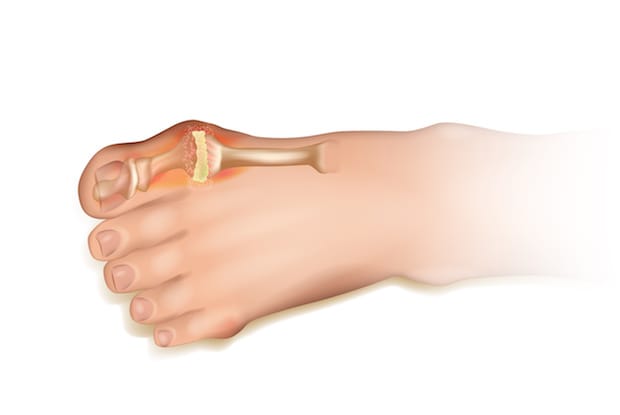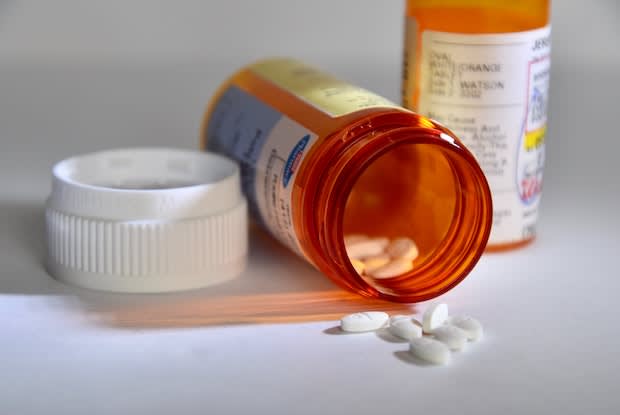Table of Contents
Understanding Gout
An attack of gout can take your breath away. Gout attacks often occur in the middle of the night, resulting in intense pain in the big toe and other joints. If gout is not treated correctly with medications like Colchicine (Colcrys), pain can also appear in the knees, ankles, elbows, thumbs, or fingers. Over 8 million Americans suffer from this form of arthritis. [1]
Gout occurs due to a buildup of uric acid in the bloodstream. Uric acid crystals accumulate in the joints, which causes inflammation and pain in the affected area. Uric acid is created when your body breaks down purines. Purines are natural substances in the body that are present in all body tissues and many foods. Our body continually processes purines and converts them into uric acid. Eating certain foods can lead to an excess of uric acid as well as malfunctioning kidneys. In some cases, it’s a combination of both.
The excess uric acid forms into crystals and inflammation then occur. These crystals may also collect in the outer ear, skin near the joints, and the kidneys. Having high uric acid (hyperuricemia) does not always lead to gout. Still, people with hyperuricemia are encouraged to make lifestyle changes to lower their risk of health problems. Read on to learn more about symptoms and treatments for gout. [2]
Get savings updates for Colchicine
Symptoms of Gout
Unfortunately, gout can only be diagnosed once the painful symptoms present themselves. The symptoms come on suddenly and typically affect one joint at first. Symptoms of gout usually include:
- Intense joint pain: Gout usually affects the big toe first. The pain can also occur in the knees, elbows, wrists, and fingers. The pain is generally severe within the first four to 12 hours after a gout attack begins.

- Inflammation and redness: The affected joint will become tender, swollen, warm, and red.
- Lingering discomfort: Gout attacks do not come and go quickly. Once the initial severe pain subsides, joint discomfort can last a few days to several weeks. The longer you have gout, the attacks are likely to last longer and affect more joints.
- Limited range of motion: Because gout affects joints, your movements may become stiff or limited as more joints are affected with urate crystals. [3]
Risk Factors
As described above, high levels of uric acid affect your chances of developing gout. The following factors can increase your uric acid levels:
- Family history: Anyone can develop gout, but if someone in your family has gout, you are more likely to develop it.
- Diet and obesity: Diets rich in red meat, seafood, and beer can increase your body's uric acid levels. Sugary beverages high in fructose may also contribute to developing gout. More uric acid is produced in those who are overweight or obese. The bodies of overweight people also have a harder time with kidney function, which can make excretion of uric acid difficult.
Gout is a progressive disease, and several stages occur with this condition. The types of gout can include: Asymptomatic hyperuricemia: This condition occurs when you have high uric acid levels but no gout symptoms. Treatment is not required at this stage, but urate crystals may be forming and beginning to cause slight tissue damage. At this stage, your doctor may recommend taking steps to reduce your uric acid levels. Acute gout: Acute gout occurs when the urate crystals are deposited and start to cause inflammation and intense pain. This attack will subside within 3 to 10 days. Stressful events, diet, and cold weather can trigger acute gout. Chronic tophaceous gout: This is a severe form of gout. When this type occurs, permanent damage may have occurred in the joints and kidneys. Chronic tophaceous gout is classified as chronic arthritis that results in the development of tophi. Tophi are big lumps of urate crystals that typically form in the joints of the fingers. This type of gout occurs several years after the onset of gout symptoms. Interval or intercritical gout: This type occurs in between attacks of acute gout. Flare-ups of gout may only happen every few months or years, but urate crystals are still being deposited in the tissue during this time. Interval gout characterizes the continuation of crystal formation. Pseudogout: Pseudogout has similar symptoms to gout, but the flare-ups of pseudogout are less severe. Pseudogout occurs with the formation of calcium pyrophosphate crystals in the joints, which differentiates it from the urate crystal formation associated with gout. Pseudogout requires different treatment than gout. [4] If you experience pain and inflammation in your joints, your doctor will perform several tests to determine the root cause. A joint fluid test will likely be performed, which involves drawing fluid from an affected joint with a needle. The fluid will be examined under a microscope for the presence of urate crystals. A blood test will better determine the levels of uric acid present in your system if urate crystals are found in your joints. To rule out other causes of joint pain, your doctor may perform an x-ray or CT scan. These procedures will determine if you have other causes of joint damage or tophi formation. In some cases, a CT scan can be used to detect urate crystals when the joint is not inflamed. [5] Improving the painful symptoms of gout typically involves medications. The goal of treatment is to treat acute gout attacks and prevent future attacks. Medications are helpful, but many gout patients must also tailor their lifestyle to improve their recovery. Maintaining a healthy diet and exercise regime is always beneficial to your overall health. NSAIDs: Nonsteroidal anti-inflammatory drugs can be used to treat pain associated with gout. Over-the-counter options include Advil and ibuprofen, but your doctor may prescribe a higher dose to stop the symptoms of an acute gout attack. NSAIDs help reduce pain and inflammation but can cause stomach ulcers if taken incorrectly. Colchicine (Colcrys): Colchicine is a medication that specifically targets gout pain. This drug is useful for gout, but it does come with side effects of nausea and diarrhea. Many feel that the benefits of Colchicine outweigh these side effects. Corticosteroids: Like NSAIDs, corticosteroids help reduce pain and inflammation in gout sufferers. They can be administered as injections into the affected joint or taken in pill form. These drugs are typically prescribed to those who cannot take NSAIDs or Colchicine. Other treatments: If you have severe gout attacks several types of year, you may require uric acid-blocking medications or medications that improve uric acid removal. You can also do several things at home to improve mild symptoms of gout, which can include herbal tea and natural supplements. [5] The content in this article is intended for informational purposes only. This website does not provide medical advice. In all circumstances, you should always seek the advice of your physician and/or other qualified health professionals(s) for drug, medical condition, or treatment advice. The content provided on this website is not a substitute for professional medical advice, diagnosis or treatment.
Types of Gout
Diagnosis
Treatment

